When we consider the subtleties of fishing, we often overlook how our equipment complements our style on the water. Whether we lean towards the tactile control of a hand-operated motor or the hands-free ease of a foot-controlled one, our choice shapes not just our experience but also our effectiveness. Have you ever wondered how the dynamics of your chosen trolling motor could redefine your approach? Let's unpack how these fundamental differences can have lasting impacts on everything from energy expenditure to the strategic approach we take on any given day out on the water.
Understanding Trolling Motors
Fishing with trolling motors opens a world of possibilities with their silent operation and advanced features. We can quietly glide through the water without scaring the fish, giving us an edge. Nearly silent operation is crucial for avoiding spooking fish, ensuring we maintain a quiet environment around them.
These motors have clever designs that cater to our need for freedom on the water. To keep them in top condition, we need to focus on motor maintenance. Regular checks, cleaning, and ensuring all components are working properly can save us time and trouble, ensuring every fishing trip is smooth and enjoyable.
Battery life is equally essential. Most trolling motors are designed for efficient power use, which means they can last longer without needing a recharge. However, keeping an eye on the battery's health is important.
Using the correct chargers, avoiding complete depletion, and occasionally using lithium-ion batteries can help maintain performance and extend battery longevity.
If we want to enjoy the perks of freedom and exploration that trolling motors offer, understanding these essentials is key. We gain not only the flexibility to navigate our boat with ease but also the confidence that our motor's powered up for the adventure we crave.
Let's hit the water prepared.
Advantages of Hand-Controlled Motors
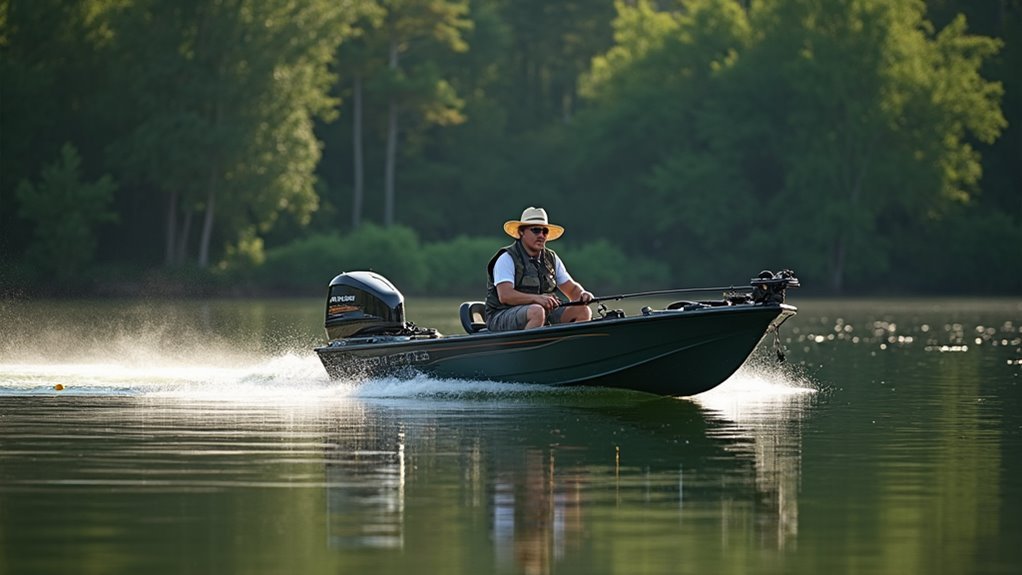
Often, when we're out on the water, hand-controlled motors provide significant advantages. They offer a clean, clutter-free deck, essential for maintaining our freedom of movement.
Let's explore why these motors might just be the right fit for our fishing adventures.
- Hand Comfort and Control Precision: Hand controls excel when precise handling is vital. These motors let us adjust direction effortlessly, allowing for precise boat positioning even in challenging conditions like winds or currents. This freedom to maneuver translates directly into more successful fishing trips.
- Ease of Installation and Flexibility: Installation is a breeze, making our setup hassle-free. Hand-controlled motors can be mounted on the transom or engine, providing flexibility. Whether we're on a canoe or a mighty Jon boat, these motors adapt well, making them ideal for various boat sizes and styles. This adaptability means that small boats like kayaks and flatboats, which are suitable for hand-controlled trolling motors, can also benefit from their unique features.
- Enhanced Boat Stability: With hand controls, fatigue lessens because we maintain equal footing, preserving our balance. This reduces the risk of slipping, a win for safe and comfortable fishing. Plus, less clutter means more deck space, enhancing our overall fishing experience.
Incorporating a hand-controlled motor could be our ticket to more enjoyable, liberating fishing adventures.
Drawbacks of Hand-Controlled Motors
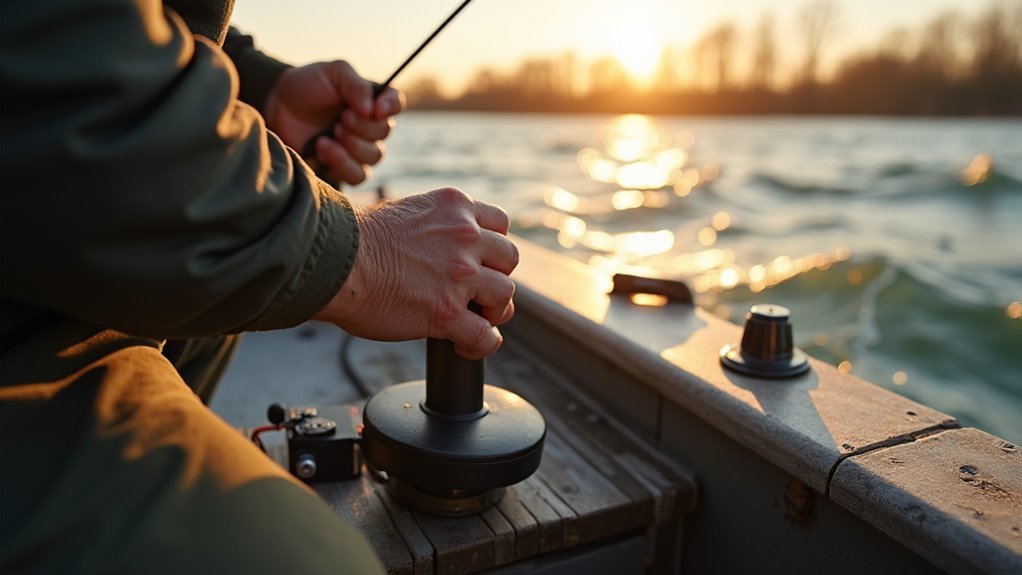
Hand-controlled motors, while offering certain benefits, have notable drawbacks that can impact our fishing experience. Imagine trying to keep our boat steady in a gusty wind or navigate through choppy waters—all with one hand tied up.
The ergonomic impact can be significant, causing fatigue from constant adjustments. We've all felt it, the strain on our muscles and focus during those long fishing trips. User feedback often highlights these challenges, pointing out how tricky it can be to maintain balance and manage control simultaneously. Despite these challenges, many find hand control relatively easy to manage while still holding the rod, lending some flexibility to the fishing process.
Space can also be a premium, especially if we're fishing from smaller boats with compact front decks. Installing a hand-controlled motor might leave us cramped, reducing our freedom to move around.
Additionally, precision becomes a real concern. When we're surrounded by tight spaces or strong currents, the limited control of a hand motor can leave us struggling to keep on course.
From the need for physical effort to difficulty reversing or making quick changes, there's much to ponder. Even seasoned anglers acknowledge that shifting to or from hand-control setups can be tough.
Benefits of Foot-Controlled Motors
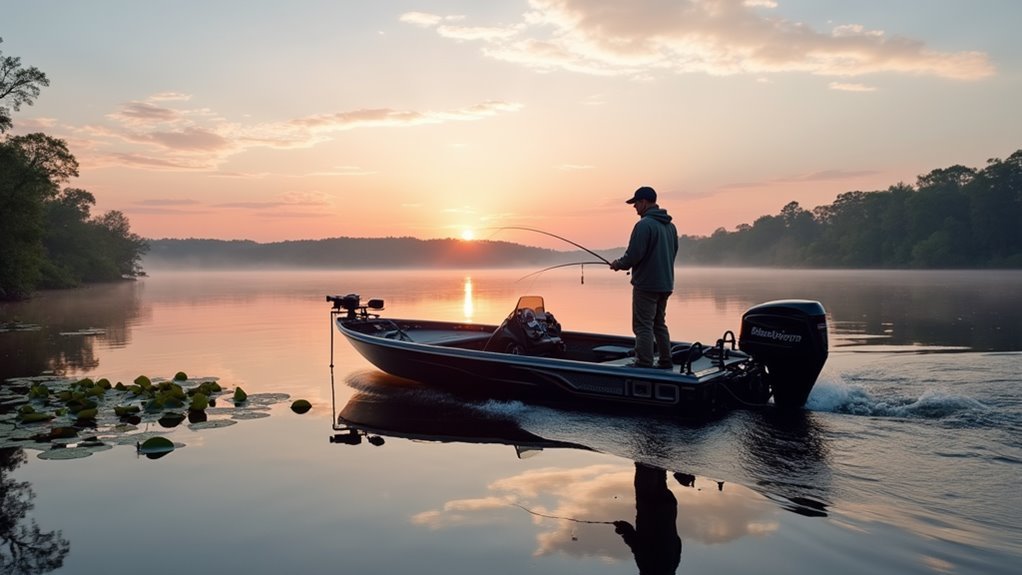
When we consider foot-controlled motors, the advantages become clear, especially for anglers seeking precision and efficiency in their fishing excursions. With foot-controlled motors, we find freedom in how we manage our boats, letting us focus on the thrill of fishing rather than the mechanics of steering. These motors are also valuable because the technology allows them to maintain position in strong currents, which proves essential for steady fishing despite environmental challenges.
Here's why they might be the perfect match for us:
- Foot Ergonomics and Space Efficiency: These motors take up less room on our boat, allowing for a cleaner setup and more space for fishing. Plus, we can place the pedal where it's most comfortable for our feet.
- Steering Precision and Continuous Movement: Direct and precise steering lets us make quick adjustments without leaving our fishing spot. The foot pedals offer immediate response, which is essential when maneuvering tricky structures like rocks or weed beds.
- Hands-Free Operation: With our hands free, we can concentrate on casting or reeling in a catch, creating a more seamless fishing experience. This is especially useful when we're standing and need that extra balance.
These motors enhance our fishing adventures, combining effortless control with a setup tailored for the versatile, freedom-loving angler.
Limitations of Foot-Controlled Motors
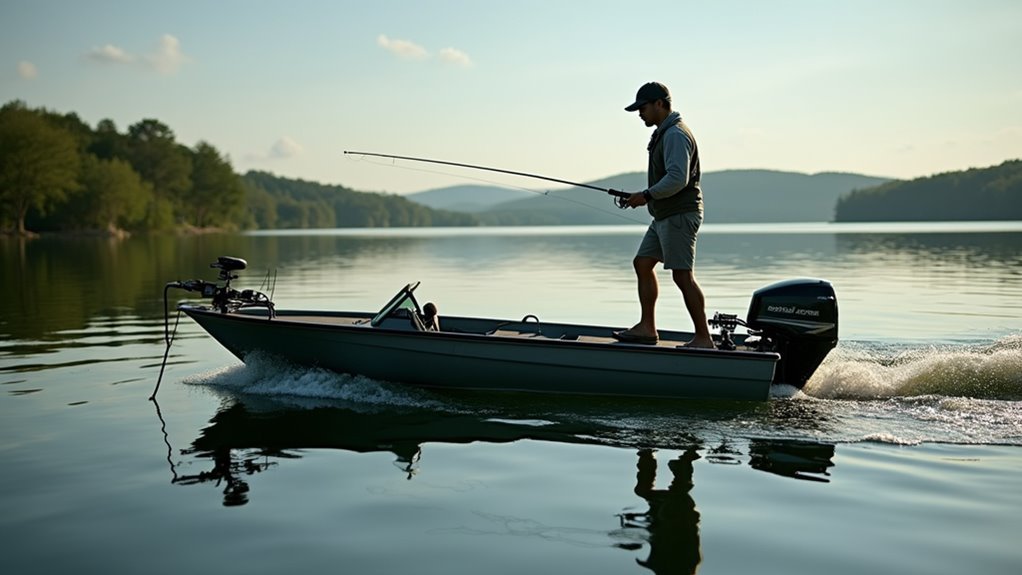
While foot-controlled motors offer undeniable advantages for many anglers, we must also consider their limitations. In respect of boat design, these motors can take up valuable space on smaller decks, leading to clutter and restricted movement. Larger boats may be necessary to accommodate foot pedals comfortably, sacrificing freedom for functionality. User feedback often highlights the fatigue that comes with standing and operating the motor for extended periods. This can strain our backs and feet, turning our peaceful fishing day into a physically demanding experience.
When it comes to versatility, foot-controlled motors may not fit every fishing style or technique. They're often limited to specific boat configurations and struggle with techniques like sight fishing redfish. Minn Kota, for example, is known for its advanced features like i-Pilot and spot lock which can enhance the experience but might not always integrate easily with foot control, further complicating things for some users.
Additionally, electronic foot pedals might lack the responsiveness of cable-steered models, leading to frustration for some anglers. Physically demanding, these motors require constant foot engagement, limiting our freedom to move around the boat. Standing for long periods can exacerbate discomfort and fatigue.
Mechanical and technical challenges exist too, with potential issues like drag in cable linkages and limitations of older electronic systems. Integrating features like i-Pilot can further affect functionality and reduce the overall fishing experience.
Comparing Ease of Use
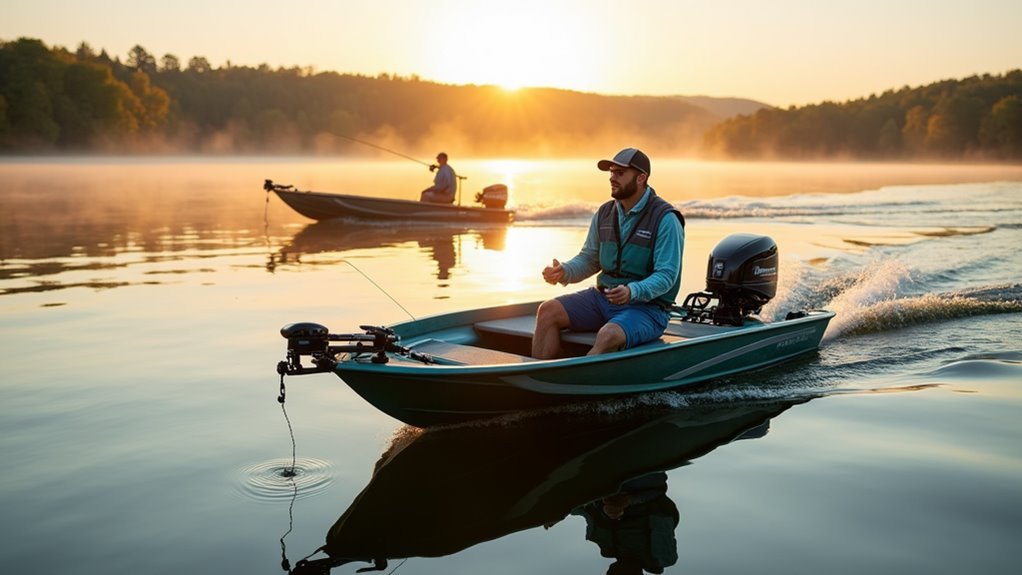
Exploring the ease of use between hand-controlled and foot-controlled trolling motors reveals distinct advantages tailored to different fishing styles. Let's delve into how user preference and control ergonomics shape our choices.
For those who crave open deck space and swift responses, hand-controlled motors shine. They're fantastic for smaller boats like kayaks or Jon boats.
Here's why:
- Deck Freedom: No foot pedals mean fewer cables, and that equals fewer tripping hazards and a tidier deck.
- Quick Adjustments: We can change speed faster and with more precision, which is essential when following fish closely.
- Easy Maneuvering: With both feet free, maintaining balance is easier, especially in smaller watercraft.
On the flip side, foot-controlled motors let us keep our hands free, offering more casting opportunities. This type becomes a favorite when fishing around tricky obstacles due to its intuitive nature for those used to its ergonomics. Despite being widely favored by 71.4% of voters, foot control still requires some adaptation when initially learning to maneuver with pedals.
However, it's important to remember:
- Some Learning Needed: Getting used to the foot controls might take a little practice.
- Familiar Feels: Many of us prefer the traditional, widespread use of foot pedals that can be more intuitive for slow movements.
Impact on Fishing Technique
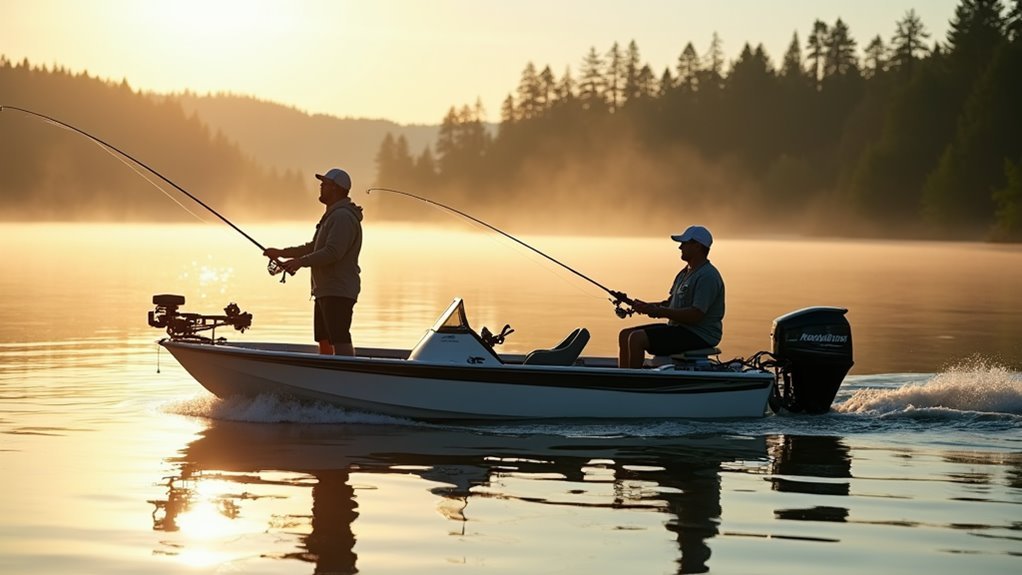
Trolling motors transform our fishing technique, granting us unparalleled tactical advantages on the water. Whether we're pursuing Bass near cover or seeking the perfect spot in open water, these motors offer us precision and control, enhancing Fishing Accuracy. Imagine having instant control for speed and direction adjustments, allowing us to avoid obstacles with ease and ensuring stability, even when the wind or currents try to push us off course. Techniques can adapt effortlessly, supporting finesse tactics and improving our stealth with reduced noise. We glide through the water efficiently, covering large areas without alarming the fish. Additionally, trolling motors allow for quiet and effortless movement through water, ensuring we can approach fish stealthily and maximize our chances of a successful catch.
By providing hands-free operation, trolling motors increase our casting freedom. We can continually cast and reel without interruption, focusing on each cast with undivided attention. This capability means more casts, more opportunities, and potentially more catches. The ergonomic benefits can't be ignored either; we enjoy reduced fatigue, a balanced stance, and freedom to move about the casting deck.
| Advantage | Impact | Benefit |
|---|---|---|
| Precision & Control | Enhanced Fishing Accuracy | Avoid obstacles easily |
| Stealth & Efficiency | Technique Adaptation | Gliding without noise |
| Casting Freedom | Continuous Casting | Increased catch potential |
Freedom on the water? We've got it in the bag!
Selecting Based on Water Conditions
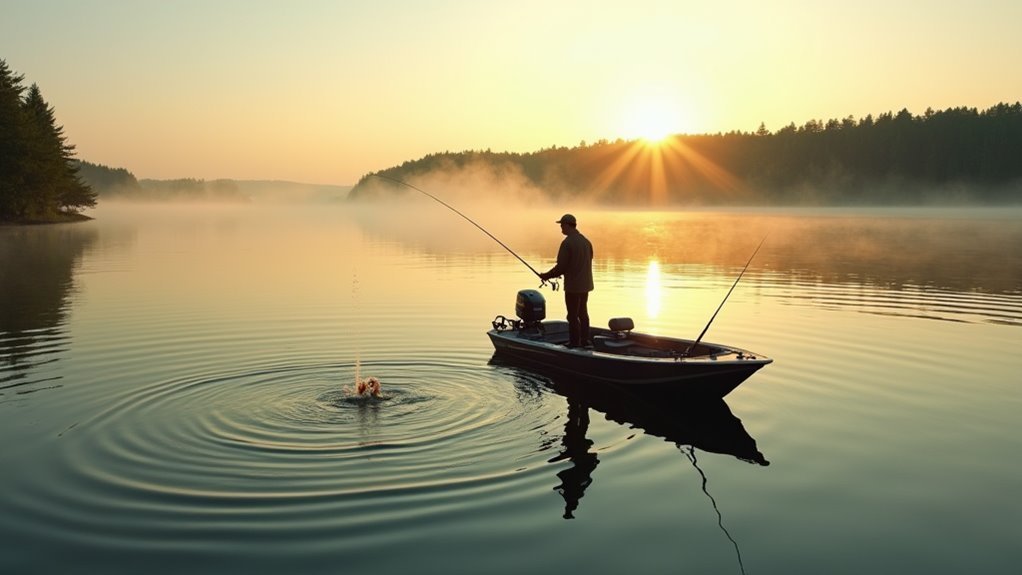
When selecting a trolling motor based on water conditions, understanding whether we'll be fishing in freshwater or saltwater is essential. The choice impacts not only our fishing experience but also the longevity and maintenance of our motor.
Freshwater offers a more forgiving environment for motor components, where Freshwater Impact means:
- Corrosion Resistance: It's less of a priority; freshwater motors can thrive without the aggressive wear that saltwater causes.
- Thrust Requirements: Typically lower due to less water resistance, helping us glide smoothly with minimal effort.
- Cost Consideration: More budget-friendly, perfect if we're watching our spending.
In contrast, Saltwater Adaptation is critical for anyone battling the harsh marine environment. Saltwater motors, although pricier, are fortified with corrosion-resistant materials. Mastering the waves more effectively may require higher thrust, but the investment guards against rust, ensuring reliability. Notably, a saltwater trolling motor can still perform in freshwater, offering durability across various environments.
Whether cruising through serene lakes or traversing restless oceans, choosing between freshwater and saltwater designs shapes our adventure. Remember, if freedom calls for varied waters, saltwater motors offer versatility we can rely on.
Understanding these dynamics empowers us to select wisely, aligning our equipment with the challenges ahead.
Making the Right Choice

Choosing a trolling motor that fits our needs is essential for an enjoyable fishing experience. We need to evaluate what kind of user experience we want. Do we enjoy hands-on control, or would we prefer the freedom to keep our hands on the rod?
Hand-controlled motors offer precise speed and direction, making our steering more intuitive, while foot-controlled motors free up our hands, an enticing option for long fishing trips. It's important to consider that foot-controlled motors, while allowing us freedom, generally have more parts prone to breaking compared to their hand-controlled counterparts, which might impact our decision if durability is a concern.
Deck space can't be ignored. Hand-controlled models keep our deck clutter-free, perfect for those of us who want space to move around easily.
On the other hand, foot-controlled motors allow versatile placement anywhere on the boat, although they introduce some clutter.
We should also evaluate seasonal adjustments. If we fish in varying conditions, a hand-controlled motor's faster response time might offer an edge in choppy waters.
Yet, the comfort of pedal operation on a long, tranquil day can't be overlooked.
Essentially, the right choice depends on how we balance control preference, boat layout, and our budget. Whether we're standing or sitting, the decision hinges on what feels more natural and comfortable for us during our fishing and boating adventures.
Frequently Asked Questions
Are Hand-Controlled or Foot-Controlled Motors More Energy-Efficient?
We prioritize battery life and minimal power consumption. Foot-controlled motors often outperform hand-controlled ones in energy efficiency due to their continuous, hands-free operation. They let us fish freely without constant adjustments, saving energy and preserving our battery.
Do Trolling Motors Impact the Fish's Behavior or Movement?
We see that trolling motors can impact fish behavior by causing habitat disruption, but they may also aid fish attraction when used stealthily. Let's embrace these nuances to optimize our fishing freedom and success.
How Do Weather Conditions Affect Trolling Motor Performance?
Temperature can cut engine power by 14%, and we feel wind resistance the most. Let's stay smart: managing swift currents and water clarity helps extend battery life. Embrace the challenges, because they make every fishing trip memorable.
What Maintenance Is Required for Different Types of Trolling Motors?
Let's guarantee our adventures aren't hampered by motor issues. We should inspect the propeller regularly and practice diligent battery care. Routine maintenance, including lubrication and bolt checks, keeps us cruising smoothly, embracing the freedom of open waters.
Are There Specific Brands Known for Better Durability in Trolling Motors?
When evaluating brand comparisons, let's prioritize material quality for long-lasting trolling motors. We trust Minn Kota, Garmin, and MotorGuide for their durable, corrosion-resistant designs. Their innovative features guarantee freedom on the water without worries about breakdowns.
Conclusion
So, we've laid it out for you—hand-controlled or foot-controlled trolling motors each have their unique perks. If you crave lightning-fast reactions, you might love the hand-controlled type. But if you're a multitasking ninja on the water, perhaps a foot-controlled motor is more your style. Remember, there's no right or wrong choice; it's about what suits your fishing adventure best. Think about what you value most and let that guide your decision. Happy fishing!